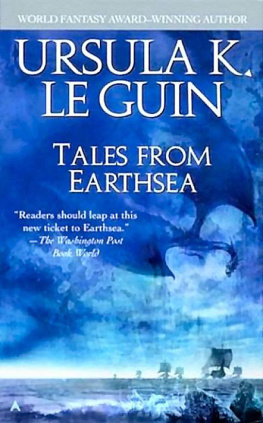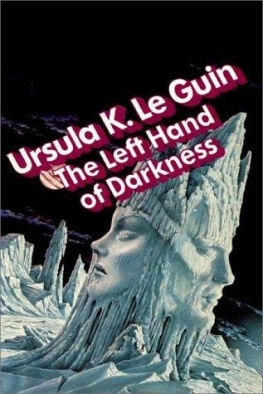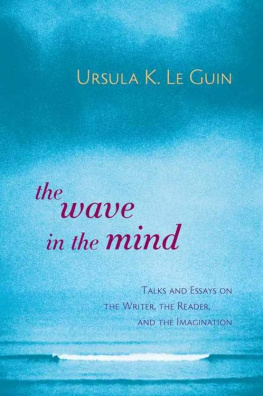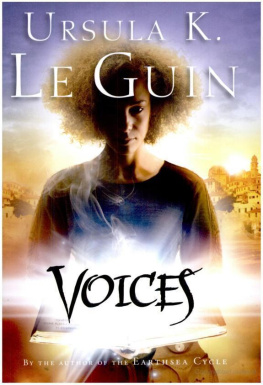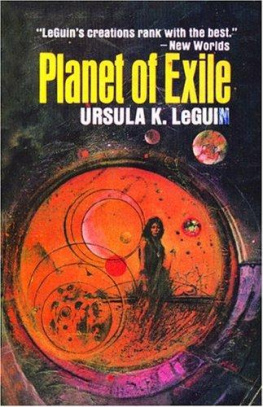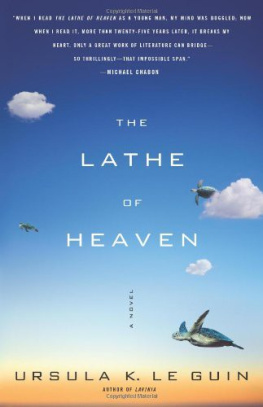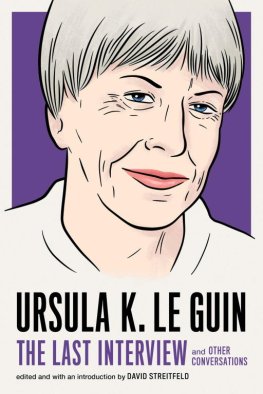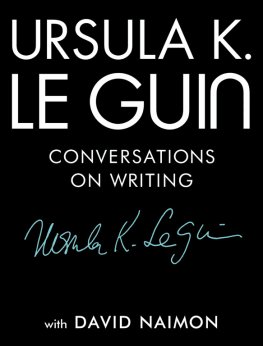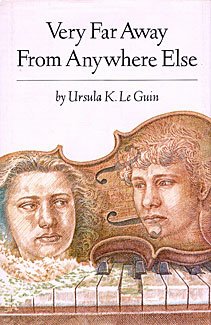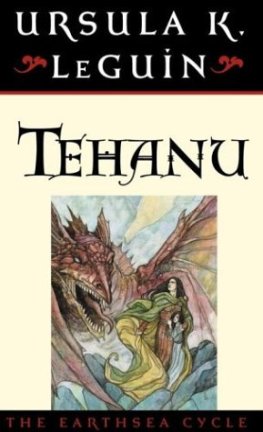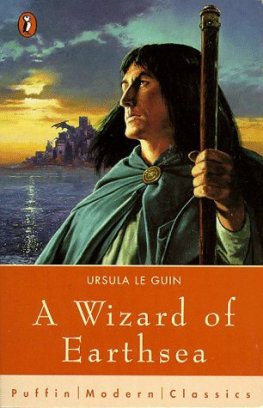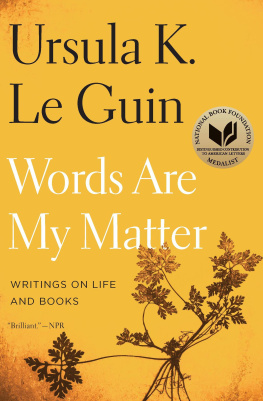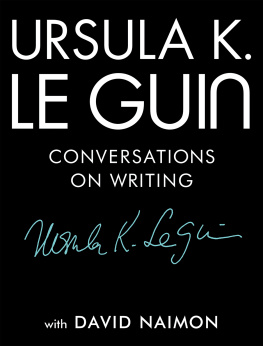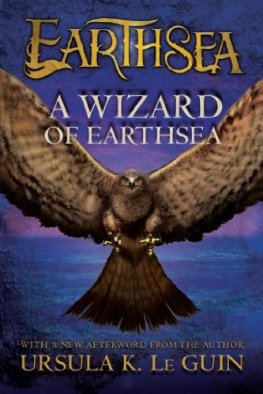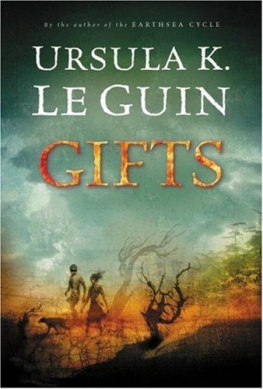TALES FROM
EARTHSEA
Ursula K. Le Guin
Darkrose and Diamond first appeared in
The Magazine of Fantasy and Science Fiction.
Copyright 1999 by Ursula K. Le Guin.
Dragonfly first appeared in Legends.
Copyright 1997 by Ursula K. Le Guin.
Library of Congress Cataloging-in-Publication Data
Le Guin, Ursula K., 1929
Tales from Earthsea / Ursula K. Le Guin.
1 st ed. p. cm.
Contents:
The finder
Darkrose and Diamond
The bones of the earth
On the high marsh
Dragonfly
A description of Earthsea.
Summary: Explores further the magical world of Earthsea through five tales of events which occur before or after the time of the original novels, as well as an essay on the people, languages, history and magic of the place.
ISBN 0-15-100561-3 I. Fantasy fiction, American, [I. Fantasy. 2. Short stories.] I. Title.
PZ7.L52I5 Tal 2001 [Fic]-dc21 2001016554
Designed by Linda Lockowitz
Text set in Adobe Jenson
First edition ACBGIKJHFDB
Printed in the United States of America
Contents
Foreword
AT THE END OF THE fourth book of Earthsea, Tehanu, the story had arrived at what I felt to be now. And, just as in the now of the so-called real world, I didnt know what would happen next. I could guess, foretell, fear, hope, but I didnt know.
Unable to continue Tehanus story (because it hadnt happened yet) and foolishly assuming that the story of Ged and Tenar had reached its happily-ever-after, I gave the book a subtitle: The Last Book of Earthsea.
O foolish writer. Now moves. Even in storytime, dreamtime, once-upon-a time, now isnt then.
Seven or eight years after Tehanu was published, I was asked to write a story set in Earthsea. A mere glimpse at the place told me that things had been happening there while I wasnt looking. It was high time to go back and find out what was going on now.
I also wanted information on various things that had happened back then, before Ged and Tenar were born. A good deal about Earthsea, about wizards, about Roke Island, about dragons, had begun to puzzle me. In order to understand current events, I needed to do some historical research, to spend some time in the Archives of the Archipelago.
The way one does research into nonexistent history is to tell the story and find out what happened. I believe this isnt very different from what historians of the so-called real world do. Even if we are present at some historic event, do we comprehend it-can we even remember it-until we can tell it as a story? And for events in times or places outside our own experience, we have nothing to go on but the stories other people tell us. Past events exist, after all, only in memory, which is a form of imagination. The event is real now, but once its then, its continuing reality is entirely up to us, dependent on our energy and honesty. If we let it drop from memory, only imagination can restore the least glimmer of it. If we lie about the past, forcing it to tell a story we want it to tell, to mean what we want it to mean, it loses its reality, becomes a fake. To bring the past along with us through time in the hold-alls of myth and history is a heavy undertaking; but as Lao Tzu says, wise people march along with the baggage wagons.
When you construct or reconstruct a world that never existed, a wholly fictional history, the research is of a somewhat different order, but the basic impulse and techniques are much the same. You look at what happens and try to see why it happens, you listen to what the people there tell you and watch what they do, you think about it seriously, and you try to tell it honestly, so that the story will have weight and make sense.
The five tales in this book explore or extend the world established by the first four Earthsea novels. Each is a story in its own right, but they will profit by being read after, not before, the novels.
The Finder takes place about three hundred years before the time of the novels, in a dark and troubled time; its story casts light on how some of the customs and institutions of the Archipelago came to be. The Bones of the Earth is about the wizards who taught the wizard who first taught Ged, and shows that it takes more than one mage to stop an earthquake. Darkrose and Diamond might take place at any time during the last couple of hundred years in Earthsea; after all, a love story can happen at any time, anywhere. On the High Marsh is a story from the brief but eventful six years that Ged was Archmage of Earthsea. And the last story, Dragonfly, which takes place a few years after the end of Tehanu, is the bridge between that book and the next one, The Other Wind (to be published soon). A dragon bridge.
So that my mind could move about among the years and centuries without getting things all out of order, and to keep contradictions and discrepancies at a minimum while I was writing these stories, I became (somewhat) more systematic and methodical, and put my knowledge of the peoples and their history together into A Description of Earthsea. Its function is like that of the first big map I drew of all the Archipelago and the Reaches, when I began to work on A Wizard of Earthsea over thirty years ago: I needed to know where things are, and how to get from here to there-in time as well as in space.
Because this kind of fictional fact, like maps of imaginary realms, is of real interest to some readers, I include the description after the stories. I also redrew the geographical maps for this book, and while doing so, happily discovered a very old one in the Archives in Havnor.
In the years since I began to write about Earthsea Ive changed, of course, and so have the people who read the books. All times are changing times, but ours is one of massive, rapid moral and mental transformation. Archetypes turn into millstones, large simplicities get complicated, chaos becomes elegant, and what everybody knows is true turns out to be what some people used to think.
Its unsettling. For all our delight in the impermanent, the entrancing flicker of electronics, we also long for the unalterable.
We cherish the old stories for their changelessness. Arthur dreams eternally in Avalon. Bilbo can go there and back again, and there is always the beloved familiar Shire. Don Quixote sets out forever to kill a windmill... So people turn to the realms of fantasy for stability, ancient truths, immutable simplicities.
And the mills of capitalism provide them. Supply meets demand. Fantasy becomes a commodity, an industry.
Commodified fantasy takes no risks: it invents nothing, but imitates and trivializes. It proceeds by depriving the old stories of their intellectual and ethical complexity, turning their action to violence, their actors to dolls, and their truth- telling to sentimental platitude. Heroes brandish their swords, lasers, wands, as mechanically as combine harvesters, reaping profits. Profoundly disturbing moral choices are sanitized, made cute, made safe. The passionately conceived ideas of the great story-tellers are copied, stereotyped, reduced to toys, molded in bright-colored plastic, advertised, sold, broken, junked, replaceable, interchangeable.
What the commodifiers of fantasy count on and exploit is the insuperable imagination of the reader, child or adult, which gives even these dead things life-of a sort, for a while.
Imagination like all living things lives now, and it lives with, from, on true change. Like all we do and have, it can be co-opted and degraded; but it survives commercial and didactic exploitation. The land outlasts the empires. The conquerors may leave desert where there was forest and meadow, but the rain will fall, the rivers will run to the sea. The unstable, mutable, untruthful realms of Once-upon-a-time are as much a part of human history and thought as the nations in our kaleidoscopic atlases, and some are more enduring.
Next page
